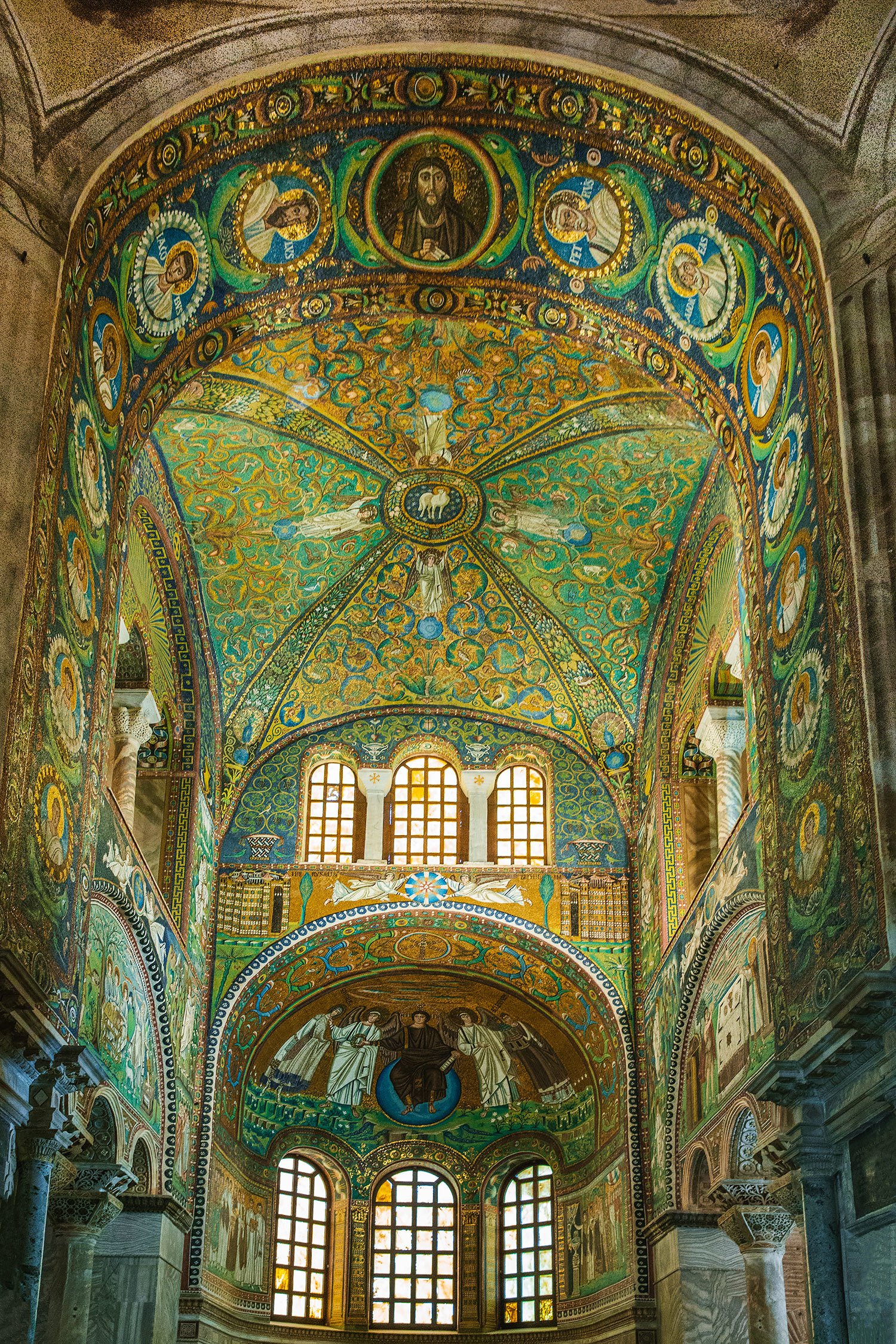Your cart is currently empty!

Ravenna Mosaics
Ravenna is the capital city of the Province of Ravenna, in the Emilia-Romagna region of Northern Italy. It is known for its well-preserved late Roman and Byzantine architecture, and has eight UNESCO World Heritage Sites. Back in Roman times Ravenna went by the name of Classe. It was an imperial port for the empire’s massive naval fleet and was even—for a brief time—the capital of eastern Rome. Then, in the mid-500s A.D., the Byzantine emperor Justinian decided that Ravenna would be the westernmost pillar of the Byzantine Empire. In a nutshell, this explains why there are so many high-quality mosaics here. The eight early Christian churches/monuments that qualify as UNESCO sites in Ravenna include:
- Baptistry of Neon (c. 430): Starting its life as a Roman bathhouse around A.D. 400, the Baptistry of Neon was later converted and attached to Ravenna’s orthodox cathedral. While the cathedral no longer stands, the baptistery has remained an important religious and cultural site for centuries.
- Mausoleum of Galla Placidia (c. 430): According to UNESCO this mausoleum is “the earliest and best preserved of all mosaic monuments, and at the same time one of the most artistically perfect.” Galla Placidia, daughter of Roman Emperor Theodosius I, was a well-known patron of the arts. Legend has it that she had this built as a mausoleum for her and her family. Three sarcophagi are there and while no one is certain, one is said to he hers, a second belongs to her husband, Emperor Constantius III, and the third is for either Galla’s son, Emperor Valentinian III, or her brother, Emperor Honorius. The mausoleum is illuminated by luminous alabaster window panels.
- Arian Baptistry (c. 500): The Arian Baptistry was erected by Theodoric the Great, king of the the Ostrogoths. The Goths (Arians) and the Latins (Orthodox) had different views of Christ. To keep the peace Theodoric built this baptistry “of the Arians” in order to distinguish it from the Baptistry of Neon (of the Orthodox) that had been built a century before. The ceiling mosaic was remarkable. The central image in the overhead dome mosaic depicts a dove (the symbol of the Holy Spirit) hovering above a naked and androgynous Jesus as he is being baptized by John the Baptist. (The white-haired, old man in a green cloak is apparently the personification of the Jordan River.)
- Archiepiscopal Chapel (c. 500), also called the Archbishop’s Chapel: The tiny cruciform chapel is currently dedicated to Saint Andrew, although the original dedication was to the Saviour, as evidenced by a lunette over the vestibule door representing Christ treading on the beasts, dressed as a general or victorious Emperor. The lower parts of the walls are lined with marble slabs, while the rest of the interior used to be covered with rich, tapestry-like mosaics, as the vault still is. Some parts of these survive, while others were substituted with tempera paintings by Luca Longhi in the 16th century. According to the ICOMOS evaluation of this World Heritage Site, “the significance of this property is the fact that it is the only Early Christian private oratory that has survived to the present day. Its iconography is also important by virtue of its strongly anti-Arian symbolism”.
- Basilica of Sant’Apollinare Nuovo (c. 500): The same man who built the Arian Baptistry, King Theodoric the Great, built this as his chapel and dedicated it to Christ the Redeemer in 504. Fifty-some years later Justinian I changed its name to Saint Martin in Golden Heaven and dedicated to Saint Martin of Tours, a foe of Arianism. It earned its present name in the 800s when some relics from Saint Appolinaris were transferred here. They say Pope Gregory the Great ordered that all the mosaics in the church be blackened. He felt that their “golden glory” distracted worshipers from their prayers.
- Mausoleum of Theodoric (520): According to the ICOMOS evaluation, “the significance of the mausoleum lies in its Gothic style and decoration, which owe nothing to Roman or Byzantine art, although it makes use of the Roman stone construction technique of opus quadratum, which had been abandoned four centuries before” and in the fact that “it is the only surviving example of a tomb of a king of this period.”
- Basilica of San Vitale (548): The Basilica of San Vitale is the best known and most popular of UNESCO’s eight sites. Its Byzantine mosaics are the largest and best preserved outside of Constantinople, so if you don’t want to go to Turkey, you need to be here. They were on the floors, on the walls, on the arches, and on the ceilings. And they were all so exquisite we didn’t know where to look. And not only mosaics, but fabulous paintings as well.
- Basilica of Sant’Apollinare in Classe (549): When the UNESCO inscribed eight Ravenna sites on the World Heritage List, it cited this basilica as “an outstanding example of the early Christian basilica in its purity and simplicity of its design and use of space and in the sumptuous nature of its decoration”. The choice of the subject is closely linked to the fight against Arianism, as it restates the both divine and human nature of Christ, the former negated by the Arians. In addition, the representation of Apollinaris among the apostles was a legitimation to Maximian as the first bishop of a diocese directly related to the early followers of Jesus, being Apollinaris, according to the legend, a disciple of St. Peter.
Get FREE access to our member’s only club and enjoy unlimited travel resources. Be the first to find out about new travel discounts and exclusive discount coupons for leading brands. Did I mention it’s all FREE? Are you in? Great! Sign up below!